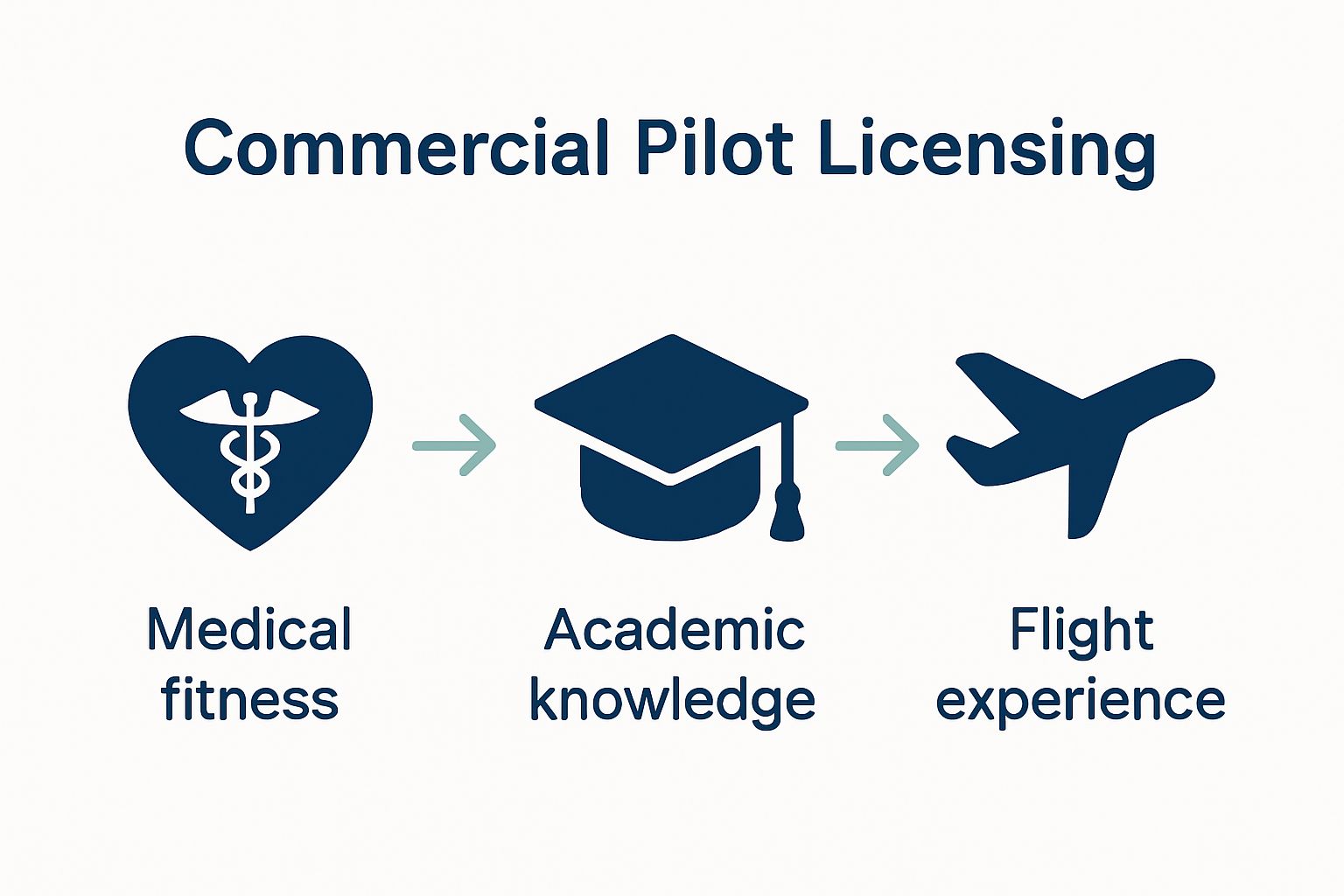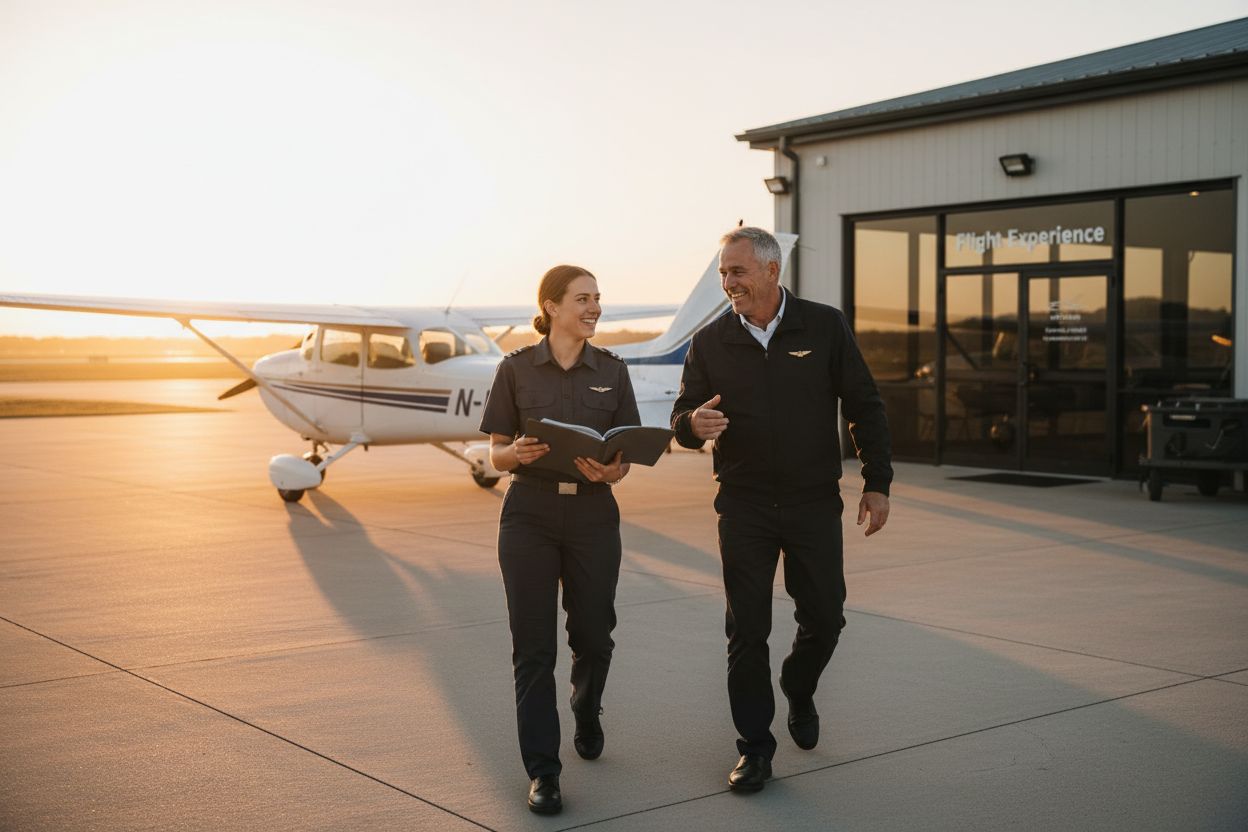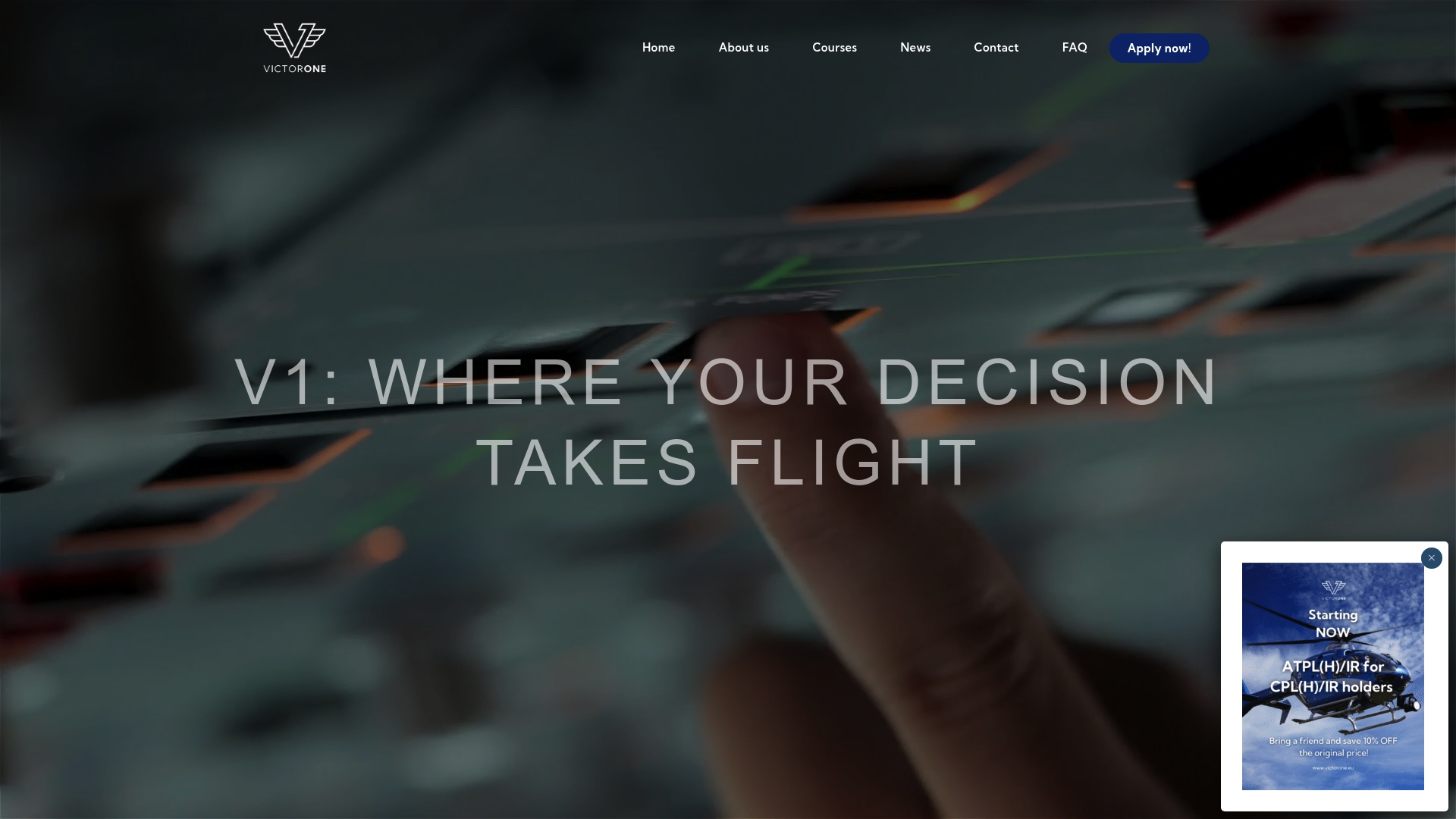Embarking on a commercial pilot career sounds straightforward, and many believe the journey is just about learning to fly a plane. The surprise is that earning a commercial pilot license includes mastering over ten core academic subjects and passing an array of rigorous medical standards. Only those who combine sharp technical skill with resilience and unfailing discipline can actually meet these requirements, turning a dream of flight into a profession trusted with thousands of lives.
Table of Contents
- What Are Commercial Pilot Requirements And Why They Matter?
- Key Components Of Commercial Pilot Training And Certification
- Understanding The Medical And Legal Standards For Pilots
- The Role Of Flight Experience In Meeting Pilot Requirements
- Exploring Additional Certifications And Ratings For Pilots
Quick Summary
| Takeaway | Explanation |
|---|---|
| Understand Pilot Requirements | Familiarise yourself with the standards ensuring safety and competence in aviation. |
| Master Theoretical Knowledge | Study aerodynamics, navigation, and regulations essential for flight safety. |
| Accumulate Flight Experience | Log diverse flight hours to develop operational skills and professionalism. |
| Pursue Additional Certifications | Enhance your qualifications with specialised ratings like instrument or multi-engine. |
| Maintain Medical Standards | Stay physically and mentally fit to operate aircraft safely and comply with regulations. |
What are Commercial Pilot Requirements and Why They Matter?
Commercial pilot requirements represent the comprehensive set of professional standards and qualifications that transform an individual’s passion for flying into a structured, legally recognised aviation career. These requirements are not merely bureaucratic hurdles but critical benchmarks ensuring safety, competence, and professional excellence in commercial aviation.
The following table outlines the core domains assessed as part of commercial pilot requirements, along with a concise definition for each, to clarify what aspiring pilots must master.
| Requirement Domain | Definition |
|---|---|
| Technical Proficiency | Demonstrated ability to operate and handle aircraft with advanced precision and control |
| Theoretical Knowledge | In-depth understanding of aeronautical science, navigation, meteorology, and regulatory frameworks |
| Medical Fitness | Adherence to rigorous physiological and psychological health standards |
| Regulatory Compliance | Fulfilment of national and international aviation laws and standards |
| Professional Conduct | Maintenance of high ethical standards and effective communication in diverse scenarios |
The Fundamental Purpose of Commercial Pilot Requirements
At their core, commercial pilot requirements exist to guarantee that every professional pilot possesses the necessary skills, knowledge, and psychological readiness to safely operate aircraft in complex, high-stakes environments. Understanding the comprehensive licensing process reveals multiple layers of rigorous assessment designed to protect both passengers and aviation infrastructure.
The requirements are meticulously crafted to validate a pilot’s capabilities across several critical domains:
- Technical Proficiency: Demonstrating advanced aircraft handling skills
- Theoretical Knowledge: Understanding complex aeronautical principles
- Medical Fitness: Maintaining exceptional physical and mental health standards
- Regulatory Compliance: Adhering to national and international aviation regulations
The Multifaceted Nature of Professional Aviation Standards
Commercial pilot requirements transcend simple flying ability. They encompass a holistic evaluation of an individual’s capability to manage sophisticated technological systems, make rapid decisions under pressure, communicate effectively, and maintain professional standards in diverse and challenging scenarios.
These standards are not static but continuously evolve, reflecting technological advancements, changing geopolitical landscapes, and emerging safety protocols. Aspiring pilots must demonstrate adaptability, commitment to ongoing learning, and a profound respect for the immense responsibility inherent in commercial aviation.
The journey to becoming a commercial pilot is fundamentally about transforming a personal passion into a professionally validated skill set that meets the highest international safety and operational standards.
Key Components of Commercial Pilot Training and Certification
Commercial pilot training and certification represent a complex, multifaceted journey that transforms theoretical knowledge and practical skills into a professional aviation qualification. This comprehensive process encompasses rigorous academic preparation, extensive flight training, and stringent regulatory assessments designed to produce highly competent aviation professionals.
Theoretical Knowledge and Academic Foundation
The academic component of commercial pilot training is a critical foundation that extends far beyond basic flying skills. Aspiring pilots must master an intricate body of knowledge covering aerodynamics, meteorology, navigation, aircraft systems, and international aviation regulations. Explore our comprehensive pilot training pathway to understand the depth of learning required.
Key theoretical domains include:
- Aeronautical Science: Understanding principles of flight and aircraft mechanics
- Navigation: Mastering complex route planning and global positioning techniques
- Meteorological Analysis: Interpreting atmospheric conditions and their impact on flight safety
- Regulatory Frameworks: Comprehending international and national aviation legislation
Practical Flight Training and Skill Development
Practical flight training transforms theoretical knowledge into operational expertise. This phase involves progressively complex flight experiences, from basic manoeuvres to advanced operational scenarios. Trainees must demonstrate precise aircraft handling, decision making under pressure, and the ability to manage sophisticated technological systems across various environmental conditions.
The certification process requires candidates to accumulate specific flight hours, pass comprehensive practical examinations, and prove their ability to operate aircraft safely and professionally in diverse and challenging scenarios. Medical fitness, psychological resilience, and continuous professional development are integral components of this rigorous journey towards becoming a fully qualified commercial pilot.
Understanding the Medical and Legal Standards for Pilots
The medical and legal standards for pilots represent a critical framework designed to ensure the highest levels of safety, competence, and professional integrity in commercial aviation. These comprehensive standards go far beyond routine assessments, serving as a robust protective mechanism for both aviation professionals and the travelling public.
Medical Certification Requirements
Medical certification is a rigorous process that evaluates a pilot’s physical and psychological fitness to operate aircraft safely. Learn more about comprehensive pilot health standards to comprehend the intricate assessment protocols that safeguard aviation safety.
Key medical certification domains include:
- Physical Health Assessment: Comprehensive medical examinations testing cardiovascular, neurological, and sensory system capabilities
- Vision and Hearing Standards: Strict criteria for visual acuity, colour perception, and auditory function
- Psychological Evaluation: Screening for mental resilience, stress management, and cognitive performance
- Ongoing Medical Monitoring: Regular health reassessments to maintain professional certification
Legal and Regulatory Compliance Standards
Legal standards in aviation are meticulously designed to create a structured environment of accountability, safety, and professional conduct. These regulations encompass a wide range of requirements, from licensing protocols to operational restrictions, ensuring that every commercial pilot meets internationally recognised competence benchmarks.
The legal framework addresses critical aspects such as licensing verification, continuous professional development, adherence to international aviation regulations, and maintaining a comprehensive record of professional achievements and training milestones.
 Pilots must demonstrate not just technical proficiency, but an unwavering commitment to ethical practices and safety protocols that protect passengers, crew, and aviation infrastructure.
Pilots must demonstrate not just technical proficiency, but an unwavering commitment to ethical practices and safety protocols that protect passengers, crew, and aviation infrastructure.
The Role of Flight Experience in Meeting Pilot Requirements
Flight experience represents the critical bridge between theoretical knowledge and professional competency in commercial aviation. It is a complex, nuanced process that transforms academic understanding into practical operational skills, serving as the fundamental mechanism through which pilots develop genuine professional mastery.
Quantitative and Qualitative Flight Hour Requirements
The accumulation of flight hours is not merely a numerical exercise but a sophisticated progression of skill development and professional validation. Discover the detailed approach to logging flight hours and understand the intricate process of professional skill advancement.
Key dimensions of flight experience encompass:
- Diverse Aircraft Exposure: Experiencing multiple aircraft types and complex operational environments
- Scenario-Based Training: Developing decision making skills through simulated and real-world flight scenarios
- Instrument and Visual Flight Conditions: Demonstrating proficiency across different flying conditions
- Multi-Crew and Solo Flight Experiences: Building collaborative and independent operational capabilities
Professional Skill Development Through Practical Exposure
Flight experience transcends simple hour counting. It represents a dynamic learning environment where pilots progressively develop critical competencies such as situational awareness, emergency response protocols, communication skills, and technological system management. Each flight hour contributes incrementally to a pilot’s professional development, transforming raw technical knowledge into sophisticated operational expertise.
The aviation industry recognises that genuine professional competence emerges not just from academic learning, but from sustained, structured practical exposure that challenges and refines a pilot’s capabilities across multiple dimensions of operational complexity.

Exploring Additional Certifications and Ratings for Pilots
Additional certifications and ratings represent sophisticated professional development pathways that significantly expand a pilot’s operational capabilities, career potential, and marketability within the aviation industry. These specialised qualifications go beyond basic commercial licensing, enabling pilots to demonstrate advanced expertise and adaptability across diverse flying environments.
Strategic Certification Pathways
Beyond the foundational commercial pilot licence, aviation professionals can pursue multiple specialised ratings that dramatically enhance their professional profile. Learn more about advanced aviation career pathways to understand the strategic opportunities available in modern aviation.
Key additional certifications include:
- Instrument Rating: Enabling complex navigation and flying in challenging meteorological conditions
- Multi-Engine Rating: Qualifying pilots to operate sophisticated multi-engine aircraft
- Flight Instructor Rating: Providing opportunities for teaching and knowledge transfer
- Type Ratings: Specific certifications for operating particular aircraft models
Professional Development and Career Advancement
These additional certifications are more than mere technical qualifications. They represent strategic investments in professional capabilities, opening doors to advanced roles such as airline transport pilots, corporate aviation specialists, flight instructors, and complex aircraft operators. Each rating demonstrates a pilot’s commitment to continuous learning, technical mastery, and professional excellence.
This table compares the main types of additional certifications and ratings available to commercial pilots, highlighting the operational advantages and professional opportunities each offers.
| Certification or Rating | Operational Capability | Professional Opportunity |
|---|---|---|
| Instrument Rating | Flight in low visibility and challenging weather | Required for most airline and advanced commercial roles |
| Multi-Engine Rating | Operation of aircraft with more than one engine | Access to more complex, high-performance aircraft |
| Flight Instructor Rating | Ability to teach and assess student pilots | Enables roles in aviation education |
| Type Rating | Proficiency in specific aircraft models | Qualification for specific commercial jet or turboprop operations |
The aviation industry recognises these additional certifications as critical indicators of a pilot’s versatility, technical proficiency, and potential for advanced career progression. By systematically expanding their skill set through targeted ratings, pilots can transform their initial commercial licence into a dynamic, multifaceted professional credential that reflects the complexity and sophistication of modern aviation.
Turn Your Commercial Pilot Ambition into Reality with VictorOne
Have you discovered how demanding and layered the path to meeting commercial pilot requirements can be? Whether the challenge for you is balancing a demanding study schedule, accessing up-to-date theory materials, or ensuring your preparation aligns with EASA standards, you are not alone. Many aspiring pilots feel overwhelmed by the technical expectations, the need for continual learning, and the complexity of choosing the right training resources. Our dedicated Academy at VictorOne resolves these worries by offering fully online aviation theory courses, delivered by experts and accessible wherever you are in the world.

Do not let uncertainty slow your journey. At VictorOne.eu, you can take the next step by enrolling in professional, globally recognised pilot training programmes. Explore flexible online learning, proven study tools, and access to licensing progression paths, including bridge courses and exam support, all designed to meet the precise requirements outlined in your commercial pilot journey. Visit our Academy page or head to the VictorOne homepage today and make your aviation career aspirations a reality.
Frequently Asked Questions
What are the essential requirements to become a commercial pilot?
To become a commercial pilot, you must meet specific training and certification standards that include obtaining a commercial pilot licence, passing medical examinations, and accumulating flight hours. Start by enrolling in a recognised flight school to begin your journey.
How many flight hours do I need to meet commercial pilot requirements?
Commercial pilot requirements typically mandate a minimum of 150 flight hours, including time spent as pilot-in-command. Plan to log these hours through flight training, solo flights, and cross-country flying to meet this benchmark effectively.
What kind of academic knowledge is required for commercial pilots?
You need a thorough understanding of aerodynamics, navigation, meteorology, and aviation regulations to meet commercial pilot requirements. Focus on studying these subjects through formal education or self-study to develop the necessary theoretical skills.
What medical standards must I meet to become a commercial pilot?
Aspiring commercial pilots must undergo rigorous medical assessments to ensure they meet specific physical and psychological fitness criteria. Schedule a comprehensive medical examination with an aviation medical examiner to verify your eligibility and maintain ongoing health checks.
Are additional certifications important for a commercial pilot?
Yes, obtaining additional certifications, such as an instrument or multi-engine rating, significantly enhances your career prospects and operational capabilities as a pilot. Pursue these additional qualifications as you progress to expand your skills and marketability in the aviation industry.
How does flight experience contribute to meeting commercial pilot requirements?
Flight experience is vital as it allows you to apply theoretical knowledge in real-world scenarios, developing essential competencies. Accumulate diverse flying experiences and log hours to ensure you are well-prepared for the practical aspects of commercial aviation.


